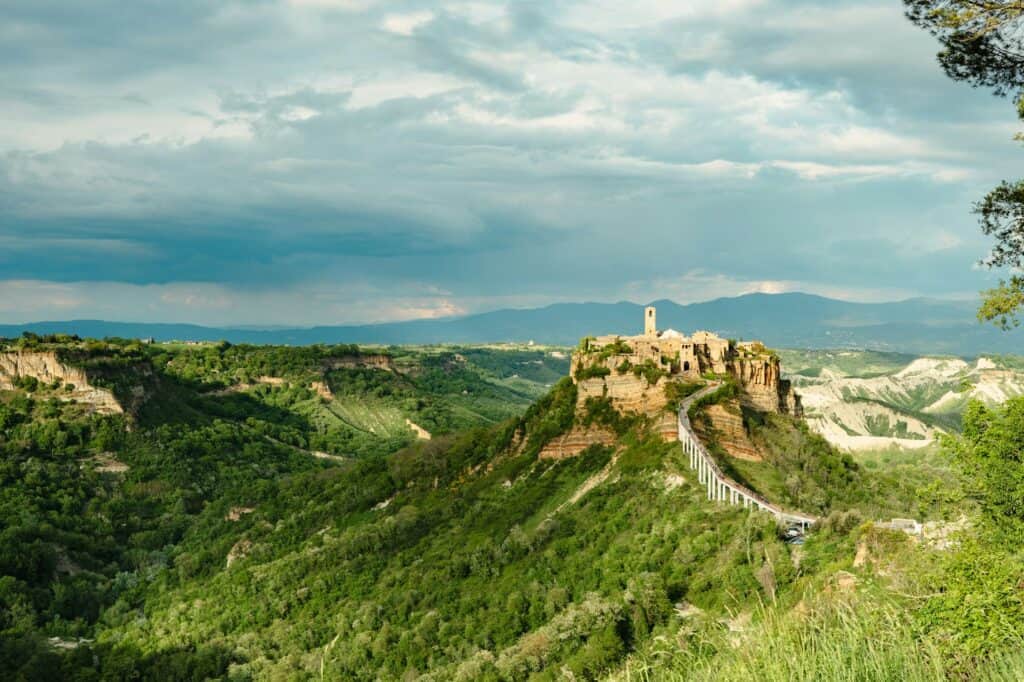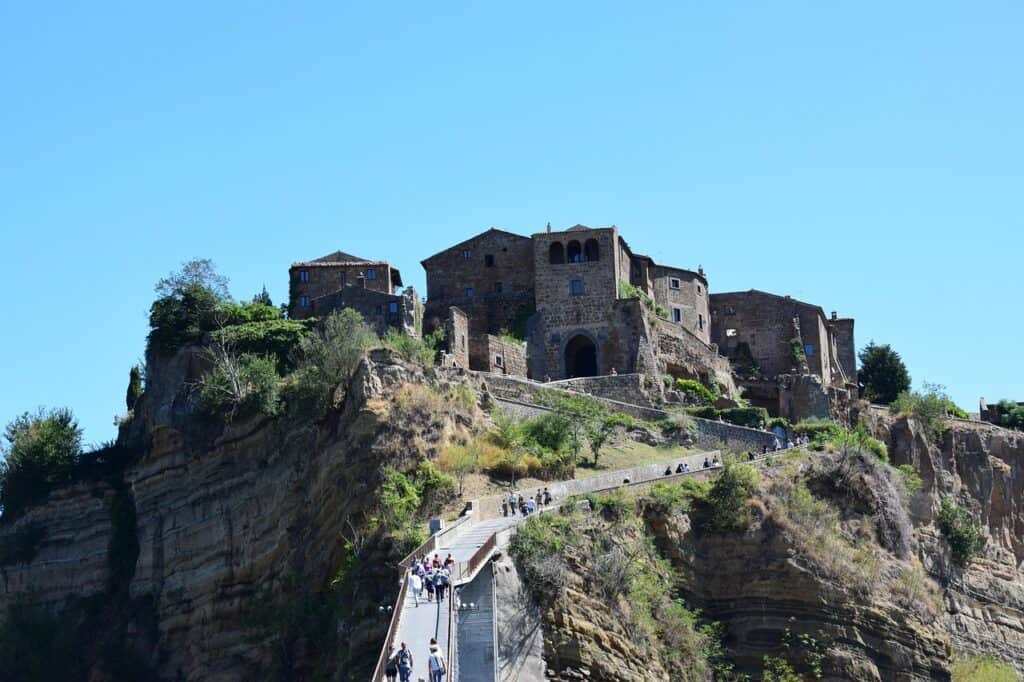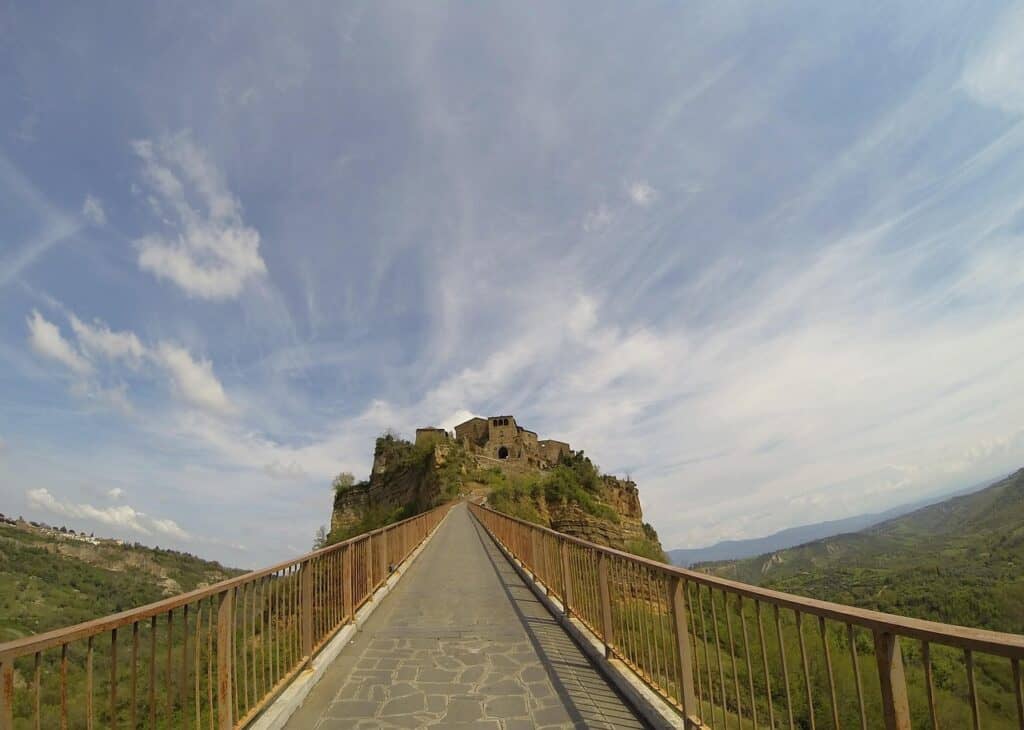We may earn money or products from the companies mentioned in this post. This means if you click on the link and purchase the item, I will receive a small commission at no extra cost to you ... you're just helping re-supply our family's travel fund.

Perched on a tufa spine above silvery badlands, Civita di Bagnoregio looks less visited than encountered. The approach is a long pedestrian bridge that lifts you out of traffic and into breath and echo. Stone absorbs light and returns it as warmth. Laundry slides between arches like quiet flags. Cats claim thresholds with the confidence of old residents. The pace changes first, then the senses. A village this small should feel fragile. Instead, it feels sure of itself.
What this really means is simple. Civita holds the past without turning it into theater. Volcanic rock keeps the floors cool, rain channels braid along walls, and the piazza handles everything from silence to festivals. The nickname dying city speaks to erosion, not spirit. The rim slumps, the core keeps faith. You arrive as a tourist and leave as a reluctant neighbor. The souvenir is a slower gait and a better appetite.
Crossing The Bridge To Another Century
The bridge begins like any walkway and becomes a rite of passage. Wind pushes your shoulders, swallows cut quick arcs, and clay gullies open like pages below. With every step, engines fade and footsteps grow present. The gate climbs from postcard to architecture. By the arch, your breathing has matched the slope and the day ahead. Crossing is not about distance. It is about resetting the metronome.
Inside, sound bends differently. Stone narrows the lane, and small voices travel far. Shoes rasp, a cart rattles, and lunch finds you before you find it. You are no longer watching a scene. You are standing inside a rhythm that existed before you and will continue when you go.
Life Inside A Suspended Village

Civita is small enough to memorize and detailed enough to keep you curious. Corners reveal tools that still work, not props pretending to be useful. Windows are deep, lintels honest, and thresholds worn smooth by decades of errands. Scale is the quiet magic. Nothing looms and nothing begs. The body relaxes because the town was built to human proportions.
Practicality explains most beauty here. Drainage spouts, carved channels, and modest vaults answer weather and weight. Elegance arrives as a side effect of solutions that last. The hill teaches limits and the architecture listens.
Not much needs to be said to enjoy this. A chair in sun, a basil pot by a stair, a bucket mark on old brick already tell a story.
Even the ordinary becomes persuasive. A broom left against stone looks like a signature, not clutter.
A Piazza That Holds The Town Together
Every path gives up to Piazza San Donato because villages need a heart to share. The church faces flagstones that shift from quiet stage to full chorus by late afternoon. Children test the square like a field of possibilities. A dog chooses the shadow of a bench and stays faithful to it. The bell does its work without argument. Time here does not insist. It invites.
On feast days, the square swells. Tables appear, voices stack, and the tower watches without hurry. Even in still hours, a chair angled toward sun suggests someone stepped away and will be back. The piazza holds both trace and promise. It feels lived rather than curated.
Where Etruscan History Sleeps Underfoot

The hill is a honeycomb. Etruscan cuts run through the tufa, where cool chambers keep wine, oil, and patience. Air holds a mineral hush. Light arrives in careful measure, respectful rather than bold. You feel craft rather than myth, work rather than spectacle. History here is a habit, not a headline.
Walk a passage and you meet the logic of survival. Steady temperature, clean water, safe storage. The rooms make ordinary life possible and therefore make celebration possible too.
Some spaces are small, but they teach large ideas. Endurance. Restraint. The intelligence of the hand.
Other marks are simply tender. A carved cross, a worn niche, a tool notch that fits a thumb.
Edges In Motion: Erosion And Care
The valley below moves with every season. Rain unthreads the clay, ridges slouch, and the rim withdraws a little at a time. Engineers shore up the weakest ribs while residents keep routines steady. The response is daily, not dramatic. Civita’s lesson is maintenance as devotion.
This fragility heightens attention. Beauty becomes persuasive when it admits limits. A place that can vanish asks you to look longer and to walk lighter. Gratitude replaces haste and turns memories into vows to return.
Doors, Arches, And Everyday Craft

The finest museum here is built into doorways. Iron knockers polished by generations, keys heavy enough to be heirlooms, arches that frame exact sky. Vines choose soft routes along mortar. Terracotta pots make parades of thyme and geranium up the stairs. Every turn offers a composition that feels earned, not staged.
Proportion does the real work. Steps that fit a stride, benches at the right lean, windows that hold light like a bowl. Comfort follows intelligence. The eye trusts what the hand would have built if given the time.
Food, Fire, And Nightfall Rituals
Meals respect proximity. Pecorino from the next hillside, oil with a green bite, beans that taste of the soil that raised them. Pasta keeps its shape because someone cared. Tomatoes wait for the right day. Porcini arrive like good news. Plates read the season with no need to explain themselves.
As the valley darkens, candles finish what daylight started. Conversations round out and neighbors visit thresholds before choosing tables. Hospitality spills outward. Doors stay open not as a performance, but because air and voices want to mix. Night softens the stone and sharpens appetite for the morning to come.